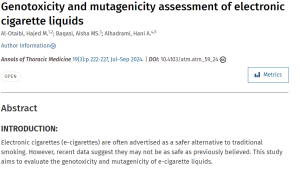New American Heart Association scientific statement outlines current science on health effects of e-cigarette use, calls for more research on long-term impact.
Statement Highlights:
- The number of people who use electronic nicotine delivery systems, typically referred to as e-cigarettes, has grown exponentially, especially among youth and young adults. E-cigarette use more than doubled from 2017 to 2019 among middle and high school students.
- Ingredients of e-cigarettes, including nicotine, flavoring agents, sweeteners and propylene glycol and vegetable glycerol, may each independently pose dangerous health risks.
- More clinical studies on the long-term impact of e-cigarettes on the heart, blood vessels and lungs are needed, and experts emphasize additional molecular and laboratory research is needed in the interim to help determine biological implications of e-cigarette use.
Embargoed until 4 a.m. CT / 5 a.m. ET Monday, July 17, 2023
DALLAS, July 17, 2023 — Research increasingly reveals health risks of e-cigarette use, and more studies are needed about the long-term impact e-cigarettes may have on the heart and lungs, according to a new scientific statement from the American Heart Association published today in the Association’s flagship journal Circulation.
The new scientific statement, “Cardiopulmonary Impact of Electronic Cigarettes and Vaping Products,” details the latest usage data and trends, identifies current health impacts, highlights existing basic and clinical scientific evidence surrounding e-cigarettes and recommends research priorities to further understand the short- and long-term health effects of e-cigarette use.
Vaping products, also known as e-cigarettes, are battery-operated systems that heat a liquid solution, or e-liquid, to create an aerosol that is inhaled into the lungs. Most e-liquid formulations deliver nicotine, which has been established as having negative health effects as well as strong addictive properties. The products may also contain other substances, most commonly tetrahydrocannabinol (THC), the psychoactive element of cannabis, as well as methamphetamine, methadone or vitamins. The liquids also include humectants (hygroscopic carriers such as propylene glycol and vegetable glycerol) that act as solvents and create a water aerosol or vapor, flavoring agents, cooling agents such as menthol and sweeteners, in addition to metals from the heating coil and other chemicals.
“E-cigarettes deliver numerous substances into the body that are potentially harmful, including chemicals and other compounds that are likely not known to or understood by the user. There is research indicating that nicotine-containing e-cigarettes are associated with acute changes in several hemodynamic measures, including increases in blood pressure and heart rate,” said the volunteer chair of the scientific statement writing committee Jason J. Rose, M.D., M.B.A., an associate professor of medicine and the associate dean of innovation and physician science development at the University of Maryland School of Medicine in Baltimore. “There has also been research indicating that even when nicotine is not present, ingredients in e-cigarettes, particularly flavoring agents, independently carry risks associated with heart and lung diseases in animals. Negative effects of e-cigarettes have been shown through in vitro studies and in studies of individuals exposed to chemicals in commercially available products.”
The writing committee points to the significance of the clinical diagnosis of “E-cigarette, or Vaping, product use Associated Lung Injury” (EVALI). EVALI was first recognized as a condition by the U.S. Centers for Disease Control and Prevention in 2019, when approximately 2,800 hospitalizations occurred among e-cigarette users in less than a year. This is cited in the statement as one example that emphasizes the lack of knowledge surrounding the risks of e-cigarettes and their ingredients. In the case of the EVALI hospitalizations, vitamin E acetate has been implicated as the ingredient likely causing illness. This substance is used as a thickening agent in some e-cigarette liquids.
Studies gauging the specific impact e-cigarettes have on heart attacks and strokes are limited. Much research on e-cigarette use has been conducted in people who have also used or were currently using traditional cigarettes. Additionally, large survey studies have focused on younger adults who have a low occurrence of heart attacks and strokes. The writing committee says longer-term studies of e-cigarettes users of all ages are needed, including among people who already have cardiovascular disease.
One recent analysis of the adult Population Assessment of Tobacco and Health (PATH) study found a statistically significant association between former or current e-cigarette use at the time participants enrolled in the study and the development of incident respiratory disease (chronic obstructive pulmonary disease/COPD, chronic bronchitis, emphysema or asthma) within the next two years. The PATH Study, an ongoing study that started in 2013, is one of the first large tobacco research efforts undertaken by the National Institutes of Health and the U.S. Food and Drug Administration.
Additional studies cited in the statement indicate a rapid increase since 2010 in the number of people who had ever used e-cigarettes or were currently using the devices, and most of those users were current or former traditional cigarette smokers. In addition, by 2016, data from the Behavioral Risk Factor Surveillance System indicated about 1.2 million adults in the U.S. who had never smoked combustible cigarettes before were currently using e-cigarettes.
The writing committee noted that e-cigarettes are reported to be the most commonly used tobacco product among youth, particularly high school and middle school students. The statement cites data showing that almost 3 out of 4 young people using e-cigarettes exclusively report using flavored e-cigarette products. This high rate of use by youth makes it critical to assess the short- and long-term health effects of these products, according to the statement.
“Young people often become attracted to the flavors available in these products and can develop nicotine dependence from e-cigarette use. There is significant concern about young people assuming e-cigarettes are not harmful because they are widely available and marketed to an age group that includes many people who have never used any tobacco products,” Rose said. “The long-term risks of using e-cigarettes are unknown, but if the risks of chronic use are like combustible cigarettes, or even if the risks are reduced but still present, we may not observe them for decades. What is equally concerning is that studies show that some youth who use e-cigarettes go on to use other tobacco products, and there is also a correlation between e-cigarette use and substance use disorders.”
Given the established, high health risks of smoking combustible cigarettes, e-cigarette products have been evaluated as smoking cessation tools. The writing committee examined the limited research in this area and concluded that any benefits e-cigarettes may offer to help people stop smoking or stop using tobacco products needs to be clearly balanced alongside the products’ known and unknown potential health risks, including the known risk of long-term dependence on these products.
“E-cigarette companies have suggested that their products are a way to quit smoking traditional cigarettes. There is no strong evidence to support this beyond any short-term benefit. The lack of long-term scientific safety data on e-cigarette use, along with the potential for the addiction to e-cigarette products seen among youth, are among the reasons the American Heart Association does not recommend e-cigarette use for cessation efforts,” said Rose Marie Robertson, M.D., FAHA, the Association’s deputy chief science and medical officer and co-director of the Association’s Tobacco Center of Regulatory Science. “It’s also important to note that e-cigarette products are not approved by the U.S. Food and Drug Administration (FDA) for tobacco cessation. The Association recommends a combination of multiple-episode cessation counselling accompanied by personalized nicotine replacement therapy with FDA-approved doses and formulations, as well as medications to help control cravings, to help people who smoke combustible cigarettes with cessation. And all of this needs to be undertaken with the understanding that quitting often takes many tries, and any failures should be seen as just episodes to learn from on the road to finally beating a powerful addiction for good.”
The scientific statement writing committee emphasizes a critical need for additional knowledge and research, specifically:
- Future research should focus on gaining knowledge about serious and potentially long-term effects of e-cigarettes on the heart, blood vessels and lungs.
- Studies are needed that include patients with pre-existing cardiopulmonary disease, such as coronary artery disease or chronic obstructive pulmonary disease, to evaluate and compare outcomes among e-cigarette users in comparison to traditional smokers, and those who use e-cigarettes along with traditional cigarettes (referred to as dual users) and nonsmokers.
- More in-depth research is needed about the common chemical ingredients in e-cigarettes and the effects they independently have on pulmonary and cardiac health.
- Clinical studies are needed to study the risks and potential benefits of e-cigarettes as alternatives to traditional combustible cigarettes.
- Since the long-term health impact of e-cigarettes may take decades to emerge, more molecular and laboratory studies are needed in the interim to help determine the biological implications of e-cigarette use.
“Because e-cigarettes and other vaping systems have only been in the U.S. for about 15 years, we do not yet have enough information on their long-term health effects, so we must rely on shorter term studies, molecular experiments and research in animals to try to assess the true risk of using e-cigarettes,” Jason Rose added. “It is necessary for us to expand this type of research since the adoption of e-cigarettes has grown exponentially, especially in young people, many of whom may have never used combustible cigarettes.”
The scientific statement was prepared by the volunteer writing group on behalf of the American Heart Association’s Council on Cardiopulmonary, Critical Care, Perioperative and Resuscitation; the Council on Epidemiology and Prevention; the Council on Cardiovascular Radiology and Intervention; the Council on Lifestyle and Cardiometabolic Health; the Council on Peripheral Vascular Disease; the Stroke Council; and the Council on Arteriosclerosis, Thrombosis and Vascular Biology. American Heart Association scientific statements promote greater awareness about cardiovascular diseases and help facilitate informed health care decisions. Scientific statements outline what is currently known about a topic and what areas need additional research. While scientific statements inform the development of guidelines, they do not make treatment recommendations.
Statement writing group members and their disclosures are listed in the manuscript.
The Association receives funding primarily from individuals. Foundations and corporations (including pharmaceutical, device manufacturers and other companies) also make donations and fund specific Association programs and events. The Association has strict policies to prevent these relationships from influencing the science content. Revenues from pharmaceutical and biotech companies, device manufacturers and health insurance providers, and the Association’s overall financial information are available here.
Source: Newsroom










